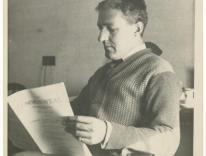 The simplest answer to that question is "yes." Neda Agha-Soltan died terribly and publicly while at a protest for freedom against a repressive regime. Her story has spun around the globe, drawing broad support and rallying the reform cause at home. (I watched the graphic video of her death, clicking without thinking, and regretted it--but on reflection realized this is what I needed to see, and to know, about the reality there. But the perils of voyeurism remain, and are troubling--another discussion.)But look more deeply at Neda and her death and we also begin to ask whatmartyrdom is.As this very good LA Times report notes, Neda seemed like a wonderful if fairly typical 26-year-old Iranian. She was from a middle-class family,was a traditional Muslim and studied Islamic philosophy at a branch of Tehran's Azad University "until deciding to pursue a career in tourism." She wasfascinated by the rest of the world. "But," the report says, "she was never an activist...and she began attending the mass protests only because she was outraged by the election results.""Martyr" comes from the Greek for "witness," and it retains that meaning in most usages today. But Merriam-Webster's two definitions also defines martyrdom as voluntarily accepting death for refusing to renounce beliefs or sacrificing for the sake of a principle. The word has both secular and religious parameters.Was Neda's death the same as that of the deaths that Christians usually associate with martyrdom? Suicide bombers and their ilk have polluted the traditional Islamic idea of martyrdom to a great extent, and Judaism developed teachings that seek to restrain martyrdom in ways Christianity perhaps has not. She is a very attractive young woman, an image that I think evokes the early virgin-martyrs of the church, perhaps.I wonder if we"construct" martyrs today for our own benefit as much assome martyrs also seek their own martyrdom, or a version thereof. This can twist reality, on the one hand, or raise someone's idea of victimization to the level of martyrdom (and victimization of the other). Both canbe self-indulgent, especially when contrasted with a true martyrdom.Neither seems quite right, and it seems Neda Agha-Soltan was neither seeking the glory of martyrdom nor looking to be any movement's emblem. But shehas become the most powerful witness possible. What ismartyrdom then?UPDATE: Hanna Rosin takes Andrew Sullivan (and others) to task for "reporting Neda myth as fact," citing a doctor's email without corroboration (which came later).
The simplest answer to that question is "yes." Neda Agha-Soltan died terribly and publicly while at a protest for freedom against a repressive regime. Her story has spun around the globe, drawing broad support and rallying the reform cause at home. (I watched the graphic video of her death, clicking without thinking, and regretted it--but on reflection realized this is what I needed to see, and to know, about the reality there. But the perils of voyeurism remain, and are troubling--another discussion.)But look more deeply at Neda and her death and we also begin to ask whatmartyrdom is.As this very good LA Times report notes, Neda seemed like a wonderful if fairly typical 26-year-old Iranian. She was from a middle-class family,was a traditional Muslim and studied Islamic philosophy at a branch of Tehran's Azad University "until deciding to pursue a career in tourism." She wasfascinated by the rest of the world. "But," the report says, "she was never an activist...and she began attending the mass protests only because she was outraged by the election results.""Martyr" comes from the Greek for "witness," and it retains that meaning in most usages today. But Merriam-Webster's two definitions also defines martyrdom as voluntarily accepting death for refusing to renounce beliefs or sacrificing for the sake of a principle. The word has both secular and religious parameters.Was Neda's death the same as that of the deaths that Christians usually associate with martyrdom? Suicide bombers and their ilk have polluted the traditional Islamic idea of martyrdom to a great extent, and Judaism developed teachings that seek to restrain martyrdom in ways Christianity perhaps has not. She is a very attractive young woman, an image that I think evokes the early virgin-martyrs of the church, perhaps.I wonder if we"construct" martyrs today for our own benefit as much assome martyrs also seek their own martyrdom, or a version thereof. This can twist reality, on the one hand, or raise someone's idea of victimization to the level of martyrdom (and victimization of the other). Both canbe self-indulgent, especially when contrasted with a true martyrdom.Neither seems quite right, and it seems Neda Agha-Soltan was neither seeking the glory of martyrdom nor looking to be any movement's emblem. But shehas become the most powerful witness possible. What ismartyrdom then?UPDATE: Hanna Rosin takes Andrew Sullivan (and others) to task for "reporting Neda myth as fact," citing a doctor's email without corroboration (which came later).
"I do not begrudge this 'doctor' his narrative. But it should not be reported by respectable American news sites as confirmation of a fact. It is an artifact in the construction of a martyr story, just like everything else in the story of Neda: Her name, which means 'voice' in Farsi (now silenced), her age, first reported as 16, but actually 27, the final close-up of her face, blood streaming from her mouth, one eye opened."
Yet martyr stories seem to be always "constructed" later, in that after the person's death they find their true meaning, through others, through re-telling.


